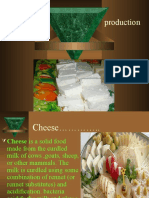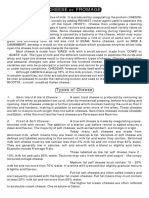Cheese Production
Cheese Production
Uploaded by
daniel holmesCopyright:
Available Formats
Cheese Production
Cheese Production
Uploaded by
daniel holmesCopyright
Available Formats
Share this document
Did you find this document useful?
Is this content inappropriate?
Copyright:
Available Formats
Cheese Production
Cheese Production
Uploaded by
daniel holmesCopyright:
Available Formats
Cheese Production: A Journey from Milk to Palate Pleasure
Cheese, a delectable delight loved by many, has a rich history dating back thousands
of years. Its production involves a meticulous process that transforms milk into a
wide array of flavors, textures, and aromas. The art of cheese-making combines
science, tradition, and craftsmanship to create this beloved dairy product.
The journey begins with the selection of high-quality milk, usually sourced from
cows, goats, or sheep. The milk undergoes pasteurization to eliminate harmful
bacteria while preserving the essential enzymes necessary for the cheese-making
process. Once pasteurized, the milk is typically inoculated with starter cultures, which
are responsible for acidifying the milk and giving the cheese its distinctive flavor
profile.
After acidification, rennet is added to coagulate the milk, forming curds and whey.
The curds are then cut, separating them from the liquid whey. The size of the curds
determines the ultimate texture of the cheese, with larger curds yielding a softer
cheese and smaller curds resulting in a firmer variety.
The curds are then drained, and depending on the desired cheese type, they may be
pressed, salted, and aged. Pressing removes additional whey, shaping the cheese into
its characteristic form. Salting enhances flavor, aids in moisture reduction, and acts as
a preservative. Aging, a critical step, allows enzymes and bacteria to interact with the
cheese, developing its taste and texture over time.
The duration of aging varies greatly, ranging from a few weeks to several years.
Some cheeses, like fresh mozzarella, are enjoyed shortly after production, while
others, such as cheddar or Parmesan, benefit from extensive aging, resulting in
complex and robust flavors.
Cheese production is a true labor of love, demanding skill, patience, and attention to
detail. From the initial selection of milk to the final aging process, each stage
contributes to the diverse and tantalizing world of cheeses that grace our tables.
In conclusion, cheese production is a remarkable blend of art and science. It
transforms milk into a myriad of flavors and textures, captivating our taste buds and
enriching our culinary experiences. Whether it's the creamy decadence of Brie, the
sharp tang of blue cheese, or the nutty nuances of Gouda, cheese-making continues
to be a cherished craft that brings joy to cheese lovers around the world.
You might also like
- The Cultural and Culinary Significance of CheeseDocument1 pageThe Cultural and Culinary Significance of Cheesedean.fencottNo ratings yet
- Making of CheeseDocument5 pagesMaking of CheeseManish JhaNo ratings yet
- CurdsDocument1 pageCurdsrubianamsalumNo ratings yet
- Cheesemaker: ProcessDocument4 pagesCheesemaker: Processmichol2014No ratings yet
- Cheese Doctoral ThesisDocument6 pagesCheese Doctoral Thesisygadgcgld100% (2)
- Cheese Production BIO 4352: DR Sydney MalamaDocument3 pagesCheese Production BIO 4352: DR Sydney MalamaLucy ZuluNo ratings yet
- CheeseDocument60 pagesCheeseshivkumar100% (3)
- "All About Cheese": IC-72376X Maj MR HussainDocument72 pages"All About Cheese": IC-72376X Maj MR HussainmohitNo ratings yet
- The Ultimate Cheese Board Cookbook: Master the Art of Delicious Entertaining with Step-by-Step Recipes, Gorgeous Photos, and Expert Tips on Wine and Drink PairingsFrom EverandThe Ultimate Cheese Board Cookbook: Master the Art of Delicious Entertaining with Step-by-Step Recipes, Gorgeous Photos, and Expert Tips on Wine and Drink PairingsNo ratings yet
- Food ProcessingDocument8 pagesFood Processingkanika_kparmarNo ratings yet
- Temporary StorageDocument1 pageTemporary StorageShriniwas KulkarniNo ratings yet
- Chapter7 Cold and Cheese PlatterDocument33 pagesChapter7 Cold and Cheese PlatterZairul SyazeriNo ratings yet
- Cheese ProductionDocument18 pagesCheese ProductionAnuj Chugh100% (1)
- Cheese ProductionDocument4 pagesCheese ProductionCiprian MocanNo ratings yet
- GM - Chapter 8 CheeseDocument35 pagesGM - Chapter 8 CheesePuteri AirinNo ratings yet
- Cheese ProductionDocument3 pagesCheese ProductionPili DiazNo ratings yet
- Group 4 CheeseDocument10 pagesGroup 4 CheeseasuncionbertmichealNo ratings yet
- About CheeseDocument35 pagesAbout CheeseCAPRINOS BAJA CALIFORNIA SUR, MEXICONo ratings yet
- Cheese: Food Production/semester2/devanganaDocument9 pagesCheese: Food Production/semester2/devanganaJai ShresthaNo ratings yet
- Classification of Cheese-1Document7 pagesClassification of Cheese-1Waqar Ibrahim0% (1)
- The History of CheeseDocument11 pagesThe History of CheeseJohnNo ratings yet
- IntroductionDocument2 pagesIntroductiondanletranthiNo ratings yet
- Cheese Part5Document16 pagesCheese Part5Hency RoseNo ratings yet
- Food Chemistry (Cheese) FullDocument11 pagesFood Chemistry (Cheese) FullAlia CameliaNo ratings yet
- CheesemakingDocument2 pagesCheesemakingsyifa salsabilaNo ratings yet
- Cheese ManufacturingDocument5 pagesCheese ManufacturingLulu AyuNo ratings yet
- Cheese Production PPT 1114fcdDocument16 pagesCheese Production PPT 1114fcdΑναστάσιος ΜπαλάσκαςNo ratings yet
- SITHCCC040 Student GuideDocument37 pagesSITHCCC040 Student GuidethebjjudadaNo ratings yet
- Sithccc017 - Cheese PT - v2Document48 pagesSithccc017 - Cheese PT - v2lim350210No ratings yet
- Cheese Production: by Primrose Katsande and Chipo ParaffinDocument17 pagesCheese Production: by Primrose Katsande and Chipo Paraffinmatthew matawoNo ratings yet
- 第五次延伸報告 秉Document15 pages第五次延伸報告 秉流川卡卡YouTubeNo ratings yet
- CHEESE MAKING PROCESS-6 STEPS - SsDocument6 pagesCHEESE MAKING PROCESS-6 STEPS - SsPaula CarosNo ratings yet
- How Is Cheese MadeDocument7 pagesHow Is Cheese MadeAdrian Joel ColombetNo ratings yet
- A Brief History of Cheese (Essay) : Fermentology - BookDocument7 pagesA Brief History of Cheese (Essay) : Fermentology - BookAuliatur RohmahNo ratings yet
- HistoryDocument3 pagesHistorydanletranthiNo ratings yet
- Steps Involved in Cheese MakingDocument2 pagesSteps Involved in Cheese MakingArunkumar KPNo ratings yet
- BSE 461 Cheese ProductionDocument40 pagesBSE 461 Cheese ProductionLizzie RungeNo ratings yet
- Cheese Production Is The Process of Transforming Milk Into Cheese by Using Bacterial CultureDocument3 pagesCheese Production Is The Process of Transforming Milk Into Cheese by Using Bacterial CultureshineadoniaNo ratings yet
- Types of CheeseDocument3 pagesTypes of CheeseDeepak JettaNo ratings yet
- 3 Cheese Pun LimitsDocument5 pages3 Cheese Pun Limitsapi-744644819No ratings yet
- CheeseDocument6 pagesCheeseIndranil ChowdhuryNo ratings yet
- Cheese ProductionDocument16 pagesCheese ProductionDr Nazia KhalidNo ratings yet
- Cheese CookeryDocument26 pagesCheese CookeryJevaughnny GreenNo ratings yet
- Tipuri de BranzaDocument24 pagesTipuri de BranzaAnamaria Blaga PetreanNo ratings yet
- Cheese CookeryDocument44 pagesCheese CookeryKayla PyneNo ratings yet
- What Is CheeseDocument2 pagesWhat Is CheeseMax BrutonNo ratings yet
- 48997019fff FNB Cheese AssignmentDocument27 pages48997019fff FNB Cheese AssignmentNicoleta Mihaela BuzaNo ratings yet
- Cheese Making ProcessDocument3 pagesCheese Making ProcessPaula CarosNo ratings yet
- Cheese Making A Step-By-Step Guide for Making Delicious Cheese At HomeFrom EverandCheese Making A Step-By-Step Guide for Making Delicious Cheese At HomeNo ratings yet
- Bio - Fermented Project (Cheese)Document3 pagesBio - Fermented Project (Cheese)Emily ZhenNo ratings yet
- 15871822311FSTSE0601 ChemistryAndTechnologyOfCheeseDocument6 pages15871822311FSTSE0601 ChemistryAndTechnologyOfCheesechemeng1No ratings yet
- How Cheese Is Made: The Cheese Making ProcessDocument2 pagesHow Cheese Is Made: The Cheese Making ProcessDaniel SanchezNo ratings yet
- CheeseDocument34 pagesCheeseThefoodieswayNo ratings yet
- FCD 09-01 Cheese Leader GuideDocument6 pagesFCD 09-01 Cheese Leader GuideAnonymous Zz1XfL5ylNo ratings yet
- 1587534860unit III Fermented Milk ProductsDocument17 pages1587534860unit III Fermented Milk ProductsSufiyan VellekattuNo ratings yet
- REPORT CHEESEMAKING FINAL REPORT - SourceDocument12 pagesREPORT CHEESEMAKING FINAL REPORT - SourceLindelwa MthembuNo ratings yet
- Visit The USDA and Other Web Sites To Gather Information About Cheeses and The Different USDA Cheese CategoriesDocument5 pagesVisit The USDA and Other Web Sites To Gather Information About Cheeses and The Different USDA Cheese Categorieskcq3bzNo ratings yet
- Cheese PresentationDocument25 pagesCheese PresentationThefoodiesway89% (9)
- 27 Different Types of Cheese, Their Origin and Uses - Food and Beverage ServiceDocument24 pages27 Different Types of Cheese, Their Origin and Uses - Food and Beverage ServiceDinealNo ratings yet
- The Fall of The Roman EmpireDocument2 pagesThe Fall of The Roman Empiredaniel holmesNo ratings yet
- The Future of Space ExplorationDocument2 pagesThe Future of Space Explorationdaniel holmes100% (1)
- Angel Falls PosterDocument1 pageAngel Falls Posterdaniel holmesNo ratings yet
- Java Class NotesDocument4 pagesJava Class Notesdaniel holmesNo ratings yet































































